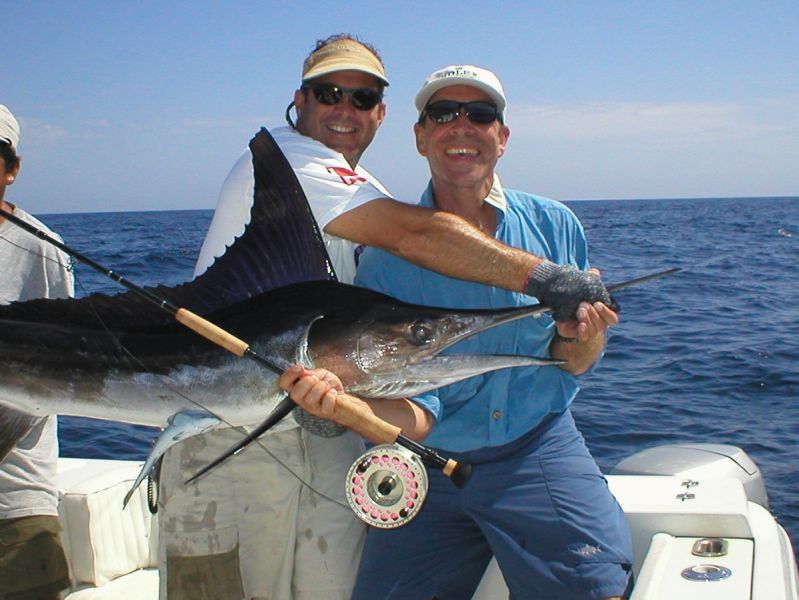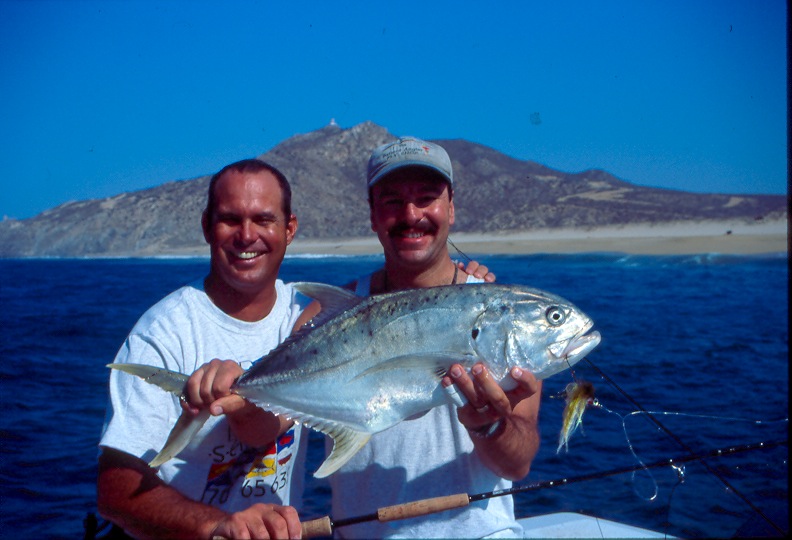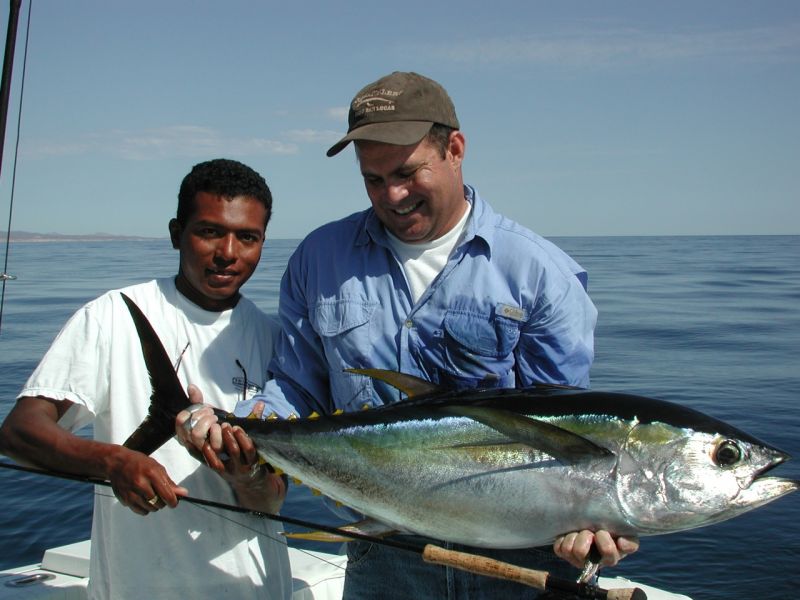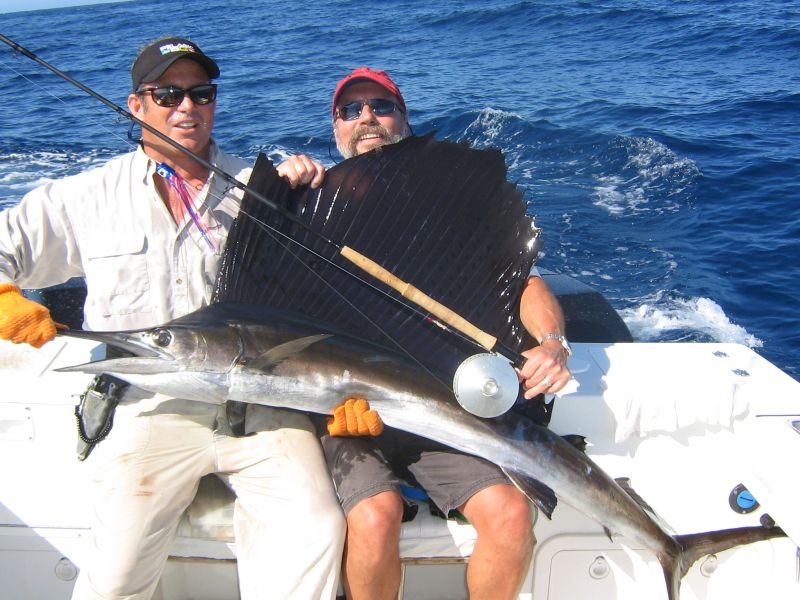Fish Seasons and Species
Click here to jump below or scroll down to browse all: Roosterfish
Striped Marlin Dorado | Jack Crevalle | Blue Marlin | Black Marlin |
Sierra Spanish Mackeral | | Sailfish | Yellowfin Tuna | Skipjack Tuna | Wahoo
Cast a fly into a trout stream and if you catch a fish it will likely be a trout. Cast into a bass pond and you'll probably catch a bass. But cast a fly or lure into the waters of Cabo San Lucas and your catch might be anything from a 5-pound Sierra mackerel to a massive blue marlin.
The area has been well-described and documented as the "world's greatest fish trap" and that's pretty much the way it is. Realistically, it is not fair to state that all species are available every day. That would be too much to ask even of Cabo San Lucas.
But from bonito to marlin, skipjack to yellowfin tuna, jack cravelle and ladyfish, there are approximately 20 species of bluewater speedsters on hand to keep things interesting. Ver-r-r-ry interesting!
On thise page you'll find a brief description of some of our most-favored targets. Check the availability of your favorite gamefish during various months of the year, factor in a bit of angling magic we call 'the unknown,' make your Cabo reservations and plan to bend a rod with us!
Roosterfish
.jpg)
Roosterfish or pez gallo are unique to the tropical Pacific. These fish are found in-shore near the sandy beaches. They are the predators of the surf. Roosterfish are members of the jack family and can grow to over 100 pounds.
There are higher concentrations of roosterfish in the waters around Cabo San Lucas than anywhere else on earth. Not only is this one of the greatest inshore gamefishes, It is also one of the most beautiful. When roosterfish are feeding in the crashing waves, it is common to see their comb-like dorsal fin slicing above the surface, raised as if a sail as it pursues its intended victim. Roosterfish can be the most selective feeder of all the oceanic sportfish. At times frustrating, the rewards can be great when one of these colorful fish pounces on your fly.
The ideal fishing situation is to find a school of roosterfish that has a school of bait herded against the shore. When this happens, the chance of a roosterfish eating your fly is greatest. I have been in the middle of hundreds of busting roosters and had them shun my fly. I changed flies with each cast until I found the one they wanted, then I had eight fish eat in almost as many casts.
The most common and challenging method of fly-fishing for roosters is to slow troll a hookless live "cabillito," this is a small jack that is very strong and hearty. Your captain or fishing partner may be the designated troller, (this can at times be more fun than being the caster) with you ready in the corner of the stern, your line stripped on the deck and the fly held in your hand. Out of the depths, a shadow appears behind the trolled bait. When it sees or senses the predator, the baitfish accelerates and the rooster instantly follows. The troller's job is to quickly reel in the line as the rooster chases the cabillito toward the boat.
When the roosterfish is within range, it is your job to get the fly in front of the excited fish. If all goes well, the rooster will charge your fly and it will disappear into its cavernous mouth. Set the hook and hold on! The initial run of the roosterfish is blistering and strong and may include many porpoise-like leaps.
Striped Marlin

Cabo San Lucas is the acknowledged striped marlin capital of the world. These super-charged rockets weigh from 50 to 300 pounds, averaging 125. Catching an IGFA-legal striped marlin on a fly is considered one of the world's greatest angling feats.
The most common way to "get a shot" at a striper is to use conventional rods and troll hookless teasers. Circling frigate birds and diving boobies will mark its position. The captain will race to the spot and begin a slow troll with the teaser. Suddenly the marlin will appear out of the blue, slashing the teaser with its bill. This marlin is so excited that it pulses colors down the sides of his body. We call it "lighting up" a marlin and it may well be the most exciting moment in your life. Good teamwork will bring the marlin to within a 30-foot cast of the transom. The captain throws the engines in neutral and the teaser is jerked from the water and into the boat.
Your turn. Cast the fly in front of and to the side of the searching fish. Make a few rapid strips of your line. Suddenly, he sees your fly, turns on it and eats it as he moves away. Wait until he turns -- a few seconds that seem an eternity. If you set the hook before he turns away, you will probably pull the fly out of his mouth. The line tightens and you set the hook, again, again, again, the water in front of you erupts and you are looking up to your fish. When he hits the water it's as if a Volkswagen fell from the sky!
He runs straight away and the reel is turning so fast that the handle is invisible. Another marlin charges out of the water 200 yards to your right. No, it's your marlin. Where your flyline enters the water a roostertail shoots 6 feet into the air. The sound this creates is like the tearing of a giant sheet. Your flyline races across the water towards the thrashing fish. With each jump you must bow to the fish as if to pay homage. The captain is bringing the boat around to give chase.
Now, it's up to you and your fish. It may take 15 minutes or 6 hours to get this fish next to the boat. Wendy's 136-pound world record striped marlin on 20-pound tippet took 2-hours, 45-minutes to boat. They are all different.
Cabo San Lucas Dorado Fishing

This may be the fish for which saltwater fly-fishing was invented. If everything is right, a dorado will eagerly chase and eat your fly. What follows will probably be the most acrobatic battles that you ever encounter.
Several years ago, Wendy and I were fishing a milling school of dorado on a mirrored sea. I had a fish on. Wendy cast straight away from the side of the boat and had a 30-pound dorado charge the fly. In a single motion it ate the fly and catapulted itself from the water, flying over the boat 10-feet above our heads. As we were looking up at the fish, the fly fell out and landed next to the boat. The dorado re-entered the water 30- feet on the other side of our boat.
Now that is a game fish!
There are several techniques for fly-fishing to dorado. These social fish will collect around any floating object. Anything that we see floating -- kelp, seaweed, debris -- gets close inspection. If there are dorado hanging around, we will stop and cast. Often, when a dorado is hooked, other fish in its group will stay around as long as it is hooked and kept in the water. At times everyone on the boat is hooked up to one of these flashing golden speedsters.
Over and under, your fellow angler is passing his rod under yours and around your body as the dorado streaks away from you on the other side of the boat. Swimming at a blistering 40-miles per hour, each leap covers 50-feet and your flyline races to catch up. The dorado is a fast-growing fish, running from 5- to 70-pounds. Your average dorado will weigh 10- to 20-pounds.
Cabo San Lucas Jack Crevalle Fishing

In Spanish, this fish is called Toro, "the bull" and that's a great description. Found in schools close to shore, the Pacific jack crevalle is quite possibly the most neglected of all the Pacific sportfish. They will readily eat a fly and the resulting battle can last a long time. Toros pull hard and long, often using their platter-shaped bodies as resistance against your efforts to turn the fish towards you.
The ideal situation is to find a large school of jacks busting bait. If the fish are actively feeding, it is possible for the captain to pull the boat next to the feeding toros. Then, it is a simple matter of presenting a fly that resembles the bait that they are eating and give it a rapid retrieve. The toro will average 8- to 20-pounds and can grow to over 40-pounds. Grant has guided all the current Pacific jack crevalle world records in the waters near Cabo San Lucas.
Sierra Spanish Mackerel

The Sierra or Spanish mackerel is often the first fish an angler encounters on a fly. They are a school fish that makes their presence known to the angler by erratic splashes on the surface created by the bait trying to escape and the predator giving chase. The disturbance attracts the attention of the gulls, boobies, pelicans and eventually the great frigate bird. Often, the swirling mass of birds can be spotted on the horizon miles away.
A wire "bite" leader is necessary when fishing for this toothy predator. The flies that we use imitate the smaller bait-fish that the Sierra feed upon.
The Sierra mackerel is considered by many to be the finest table fare of all the Pacific species (particularly prized as the main ingredient of ceviche) and a great sportfish.
Cabo San Lucas Black Marlin Fishing

A black marlin over 1,000 pounds is called "a grander" and is considered the ultimate marlin trophy. For fly-fishing, however, we look for the "rat," a black marlin under 200-pounds. In years past, fly-fishers pursuing a black marlin have traveled to Townsville, Australia, and the Great Barrier Reef. This has always been considered the top spot in the world for flyrod-caught black marlin. Three of my friends have caught world record fish in this area. The late great Les Eichorn came close to shattering the record books with a black marlin on 16-pound tippet that was lost at gaff. Credible witnesses guessed the marlin to be 300-pounds! Ray Beadle's two world record black marlin on 12- and 16-pound tippet have stood the test of time. Trey Combs set the mark on 20-pound tippet a few years back.
During certain times of the year, there are concentrations of these "rats" around Cabo. I predict that we will see world record blacks caught here in the future.
Cabo San Lucas Blue Marlin fishing

Blues are the largest of the Pacific marlin and present the ultimate challenge for the flyrod and light tackle angler. The challenge develops from a combination of proportion (these fish get huge!) and keeping these fish hot on the teaser.
A striped marlin or sailfish might stay on a teaser all the way to the transom and hang around searching for the lure even after it is pulled from the water. The blue marlin, however, is a more wary predator and often will hit the teaser and go away before the angler or the crew has time to react. They attack their prey from beneath with an explosive fury.
Blue marlin grow to over a 1,000-pounds! For fly-fishing, we target blues that range between 50- and 200-pounds.
When fly-fishing or pursing blue marlin with light tackle, a skilled crew is a must. Once teased and then hooked, the skill of the angler and crew comes into play. Never have you seen such power as when the marlin erupts into the air, like a Polaris unleashed. The fish is moving so fast that the crew must give chase with the boat. If the tippet holds and you are not "bill-wrapped", if everything is right and you land one of these giants, you have accomplished what few flyrodders in history have experienced: A fly-caught blue marlin!
Cabo San Lucas Yellowfin Tuna Fishing

This is the fish that launched the famed long range sport-fishing fleets of San Diego. And for good reason. Pound-for-pound, the tunas pull with more strength and endurance than any other fish in the world. You don't finesse a tuna, you slug it out. I was once spooled by a tuna. We were fishing aboard the Royal Star, drifting over Thetis Bank. The sea was choppy and we didn't have any skiffs in the water. Suddenly, we were in the middle of a "breezing" school of tuna and marlin. I grabbed my 14 weight rod rigged for marlin and cast as the school charged past the boat. As the fly was sinking, I made a rapid strip. There was a solid take and I set the hook. It was like hooking a truck at 40 MPH. It was evident that this was not a marlin because the fish did not change course or speed. The crew scrambled to get a skiff in the water so we could give chase. After an uninterrupted run of 750 yards, I looked at the reel and saw the arbor through a few remaining wraps of backing. I had no choice but to lock down on the running fish with the hope that he would turn. He didn't and my tippet broke. We never saw the fish, but it was either a big yellowfin tuna or a nuclear submarine. I am convinced that tuna never knew he was hooked.
One method of fly-fishing for yellowfin tuna is to chum them up to the surface using live bait. When the fish are actively "boiling on the bait," it's time to cast your fly into the melee. When a tuna eats your fly, there is no doubt who is in control. He is.
The initial run may last 200 yards or until you turn the fish. This is where a high quality reel that costs hundreds of dollars comes into play. Your drag must be cranked down and at this point, anything that can break will. It is up to you how long the battle lasts. If you pressure the fish, it may be landed in minutes. There have been tuna battles that have lasted much longer. The average size yellowfin will weigh 8 to 30 pounds. As a rule of thumb, figure on a minute a pound to land a yellowfin.
These fish grow up to 300 pounds!
Another common method of fishing for yellowfin tuna is to watch for diving schools of birds. This will signal a school of tuna busting bait on the surface. If the captain sees this, hang on! The throttles are full forward and you are racing towards the boiling mass of bait, birds and tuna. As the captain approaches the melee, he will determine both the direction of the wind and school of fish. The skipper will always try to put you above and down wind of the moving fish.
The thrill and excitement of being so close to a massive feeding frenzy is difficult to describe. The frothing water, the smell of fish in the air and the deafening roar all have to be experienced to be believed. If you have a fly on that resembles the bait that is being eaten (these tuna can be remarkably selective) and if you can get a cast in the water before the fish sound, you are guaranteed a hook-up with Mr. Tuna.
Cabo San Lucas Sailfish
This fish introduced the public to the previously unheard of concept of fly-fishing for billfish. Many consider the sailfish to be the easiest of all the billfish to take on a flyrod, essentially because Pacific sails readily come to the teaser.
When a sailfish is up on the teaser, it will often focus its interest to the exclusion of all else. Sometimes, a sail -- pez vela in Spanish -- can be brought all the way to the boat's transom. Then, if everyone does everything correctly and it's your lucky day, the sailfish will eat your fly. When it does, the acrobatic display is matched by no other fish on earth. This fish has been clocked at 60 MPH!
The techniques we use to tease Cabo San Lucas sailfish are the same as for marlin: Tease and switch.
Unlike the marlins, the sailfish does not sound or fight deep. Pez vela spend most of the battle on or near the surface. This makes for a battle of shorter duration, with the sailfish expending all its energy trying to rid itself of the hook. The average Cabo sailfish will weigh 80 to 100 pounds.
Black Skipjack Tuna

This is the strongest of all the tunas and probably the most under-rated Pacific sport fish. Serious tuna anglers believe that black skippies would be "un-landable" if they grew to the size of the yellowfin. The black skippie will average 8- to 15-pounds with the all-tackle world record weighing over 20-pounds.
Several years ago, while on a fly-fishing trip to central-mainland Mexico, Wendy, Russell Sullivan and I rewrote the record books on these fish. Since then, new records have been established on the long range fly-fishing trips aboard the Royal Star.
The black skipjack is found in schools that herd bait to the surface. Schools often cover several acres of ocean. It is an incredible sight, diving birds, thrashing fish and bait fish leaping above the surface in a vain effort to escape the predators below. If you do not get too caught up in the spectacle and can get your fly into the water and make a it move, a skippie is guaranteed to eat your fly. The initial run will follow the school, then, as the fish realizes it is hooked, the battle will turn into a give-and-take "slug fest."
I once watched a friend battle a fish he thought might be so large that it could capsize the boat if brought too near. After an epic 20 minute battle, a 7-pound skipjack appeared at the surface. I fell to the bottom of the boat laughing at the puzzled expression on my friend's face. If you hear my friend tell the story, he claims that a "giant" fish let go of the skipjack just before it reached the surface.
Cabo San Lucas Wahoo Fishing

Let there be no question that this is the fastest fish in the ocean. Fishery experts put their speed at about 70 MPH, but personally I think it's faster! At least it is when you're hooked to one.
These fish have more legends surrounding their feats than any other fish. Buy me a beer sometime and I will share a few stories about my personal experiences with wahoo. I have always imagined the way these fish received their name. They were probably named by the first person who hooked one. As the fish ran away from the angler at 60+ MPH, the angler screamed, "Wahoo!" Suddenly, the fish turned 180 degrees and charged the boat with the fisherman under his breath muttering, "Oh no! Oh no!" To this day it is wahoo or ono. Until recently, this fish was considered un-catchable on a fly. The first IGFA-legal wahoo was caught by Stu Apte off the coast of Panama. Only a couple of IGFA-legal flyrod-caught wahoo had been landed prior to Ed Rice's first annual Blue Water Flyrod Invitational, aboard the Royal Star out of San Diego. This trip was historic in many respects, not the least of which was the fly-fishing talent that was gathered . . . Beadle, Wolverton, Rice, Abel, Curcione, Whitlock, Apte, Combs, Parker, Byford and Hanvold (before Wendy and I were married.) The year before, on Steve Abel's pioneer outing on the Royal Polaris, we had found plenty of wahoo near the Alejos Rocks, but were unable to get them to eat our flies. We thought that we were not stripping them fast enough. On Rice's trip, we discovered that a fly left to sink or one that was slowly stripped elicited strikes from these lightning-fast predators. More wahoo were landed on this trip than in the previous history of our sport.
The records fell and will continue to fall as more people learn to fish for this ferocious speedster. The most common method of fly-fishing for wahoo is to troll a large plug. When a strike occurs, the fish is quickly reeled in and a fly is cast along with some live chum. These fish usually travel in packs and will often hang around as the hooked fish is brought to the boat. After the cast is made, allow your fly to slowly sink. Your drag must be set light; when this fish eats your fly it will be the strongest fastest run in the ocean.
Yellowtail













